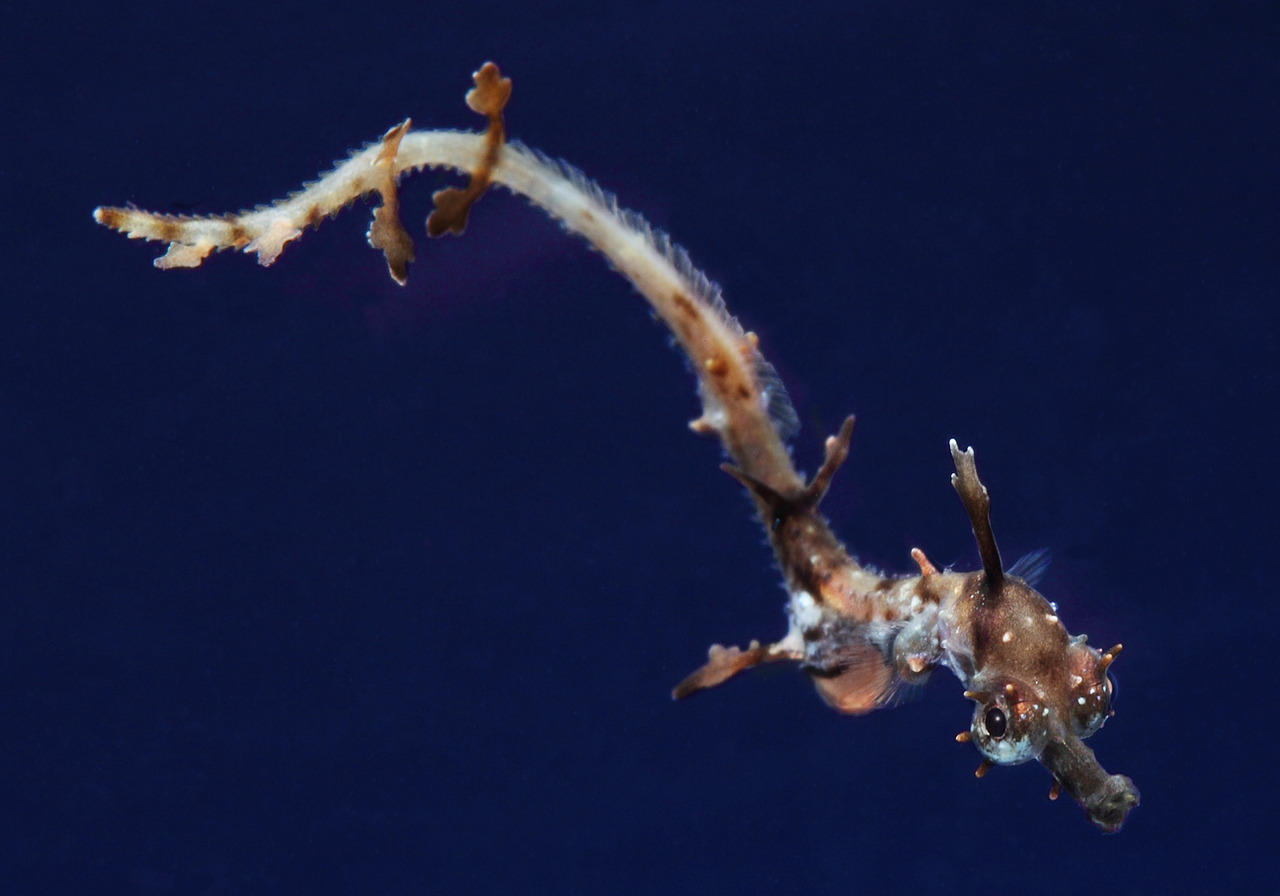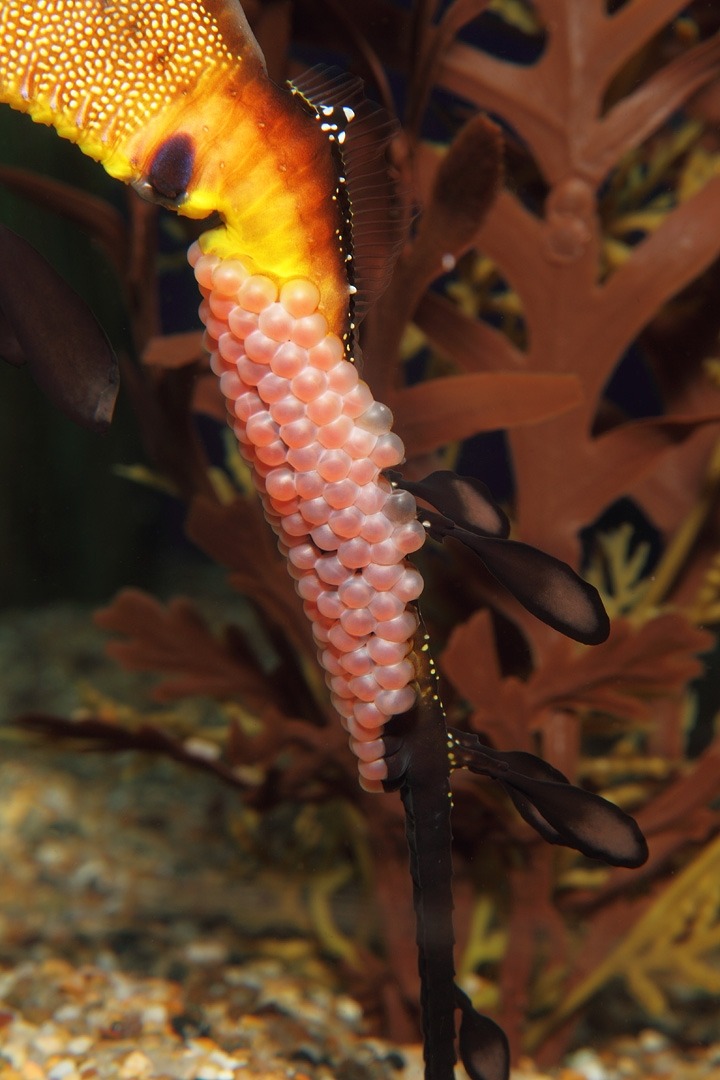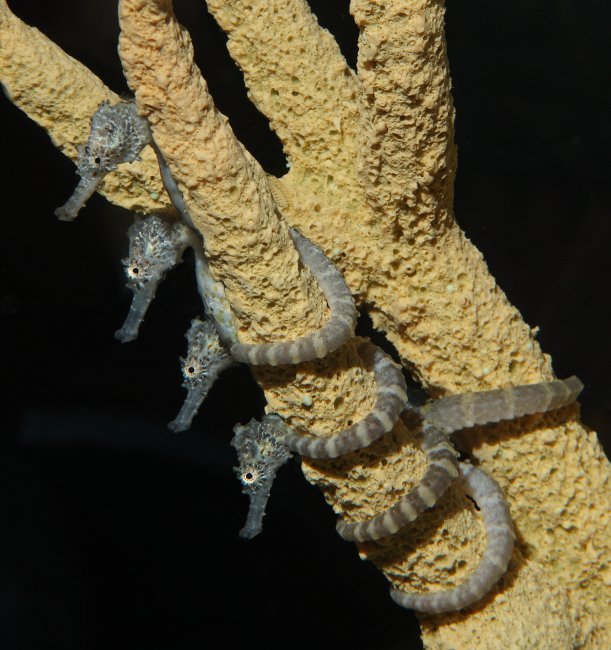Behind the Scenes at the Seahorse Exhibit

The Secret Lives of Seahorses special exhibition has become one of the most popular in the history of the Monterey Bay Aquarium. It’s also been a labor of love for the Aquarium’s husbandry staff.
“It’s been hugely rewarding to see how well it’s been received,” says Jonelle Verdugo, associate curator of fish and invertebrates. “Years ago, when we thought of doing a seahorse exhibit, we knew it would be popular, but we didn’t expect it to be one of our highest-rated temporary exhibits.”
Along the way, Jonelle and her staff have learned a few of their own seahorse secrets.

A Seahorse Laboratory
Behind the scenes, there are rows of tanks, large and small, full of seahorses of every size. A thicket of pipes and tubes run down the aisles, keeping the water clean and aerated. Charts and white boards indicate recent work performed. Staff and volunteers scurry about with siphons and cleaning equipment. It’s a daunting task to keep 19 species healthy and cared for (including seahorses, sea dragons, pipefish, and pipehorses), but at the same time, it all looks orderly and efficient.
Seahorses may be small, but they can be quite demanding. It takes three full-time staff to run the exhibit, plus five part-time workers and 12 volunteers. “It’s a lot of work,” says Jonelle. “It has to do with the size of the exhibit, the number of animals, and the fact that each exhibit tank can be tough to access.”

Feeding is a never-ending task. “Seahorses have no true stomach,” says Jonelle. “That means they need to eat a lot. Food passes through them quickly.” Adult seahorses are fed two times a day, sub-adults are fed three times daily, “and babies are fed constantly,” says Jonelle. The type of food depends on the size of the seahorse, and includes everything from plankton (for babies) to mysid shrimp and krill (for large, fully grown animals).
And, not surprisingly, all that food needs to go somewhere after it’s eaten. “We don’t want poop or leftover food to sit in the exhibit or holding tanks. So it’s a matter of constantly feeding, cleaning, feeding, cleaning….”
The staff does a “gravel wash”—using a vacuum-like device—twice each day. Several exhibits are large enough for aquarists to stand in while cleaning. The sea dragon displays are actually big enough that staff can don dive gear and get completely underwater to do their work—though it’s a bit of a contortion act. About once a month, staff stays after hours for a “deep cleaning,” spending a few hours scrubbing everything and bleaching the plastic algae.
And it’s not just seahorses and their kin that need to be cared for—there are also 10-15 non-seahorse species in the exhibit, including fish, urchins, crabs and the like.

Babies Behind the Scenes
Part of the fascination with seahorses is their reproductive process—the males become pregnant and give birth. “We’ve seen babies from all nine seahorses species that we have here,” says Jonelle. “There have been some weeks where we’ve had babies every morning.” Species producing young on exhibit include the longsnout, zebrasnout, potbelly, yellow and White’s seahorses. Those producing behind the scenes include the Pacific, lined, dwarf and shortsnout seahorses.
They typically go into labor in the wee hours of the morning. When the aquarists arrive, the first step is to remove and isolate the juveniles to ensure they get enough food. The tool of choice for this? A turkey baster. “We need to suck them up and not expose them to the air,” says Jonelle. “And a net would damage them.”
Next, the miniature seahorses are placed in a fish bowl, which is suspended in a larger tank to ensure a uniform water temperature. For some species, like the Pacific and yellow seahorses, a current is provided to ensure they don’t become stuck at the surface, where they might ingest air and become buoyant. Other species, like the White’s and potbelly seahorses, use their tails to grab onto objects and remain in mid-water. Some even grab onto each other, forming a “daisy chain” that can be 5-10 seahorses long.
“We’ve been making big steps forward in learning how to raise many of the species that we have. Our hope is to become self sufficient and keep our exhibit stocked as well as being able to send surplus animals to other aquariums.”
When it comes to seahorses, it’s all part of a developing science. “We’re always learning how to make things better,” says Jonelle.
Visit soon, as the exhibit closes Labor Day 2013!






